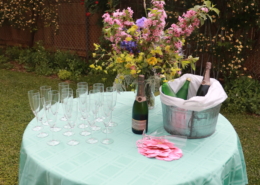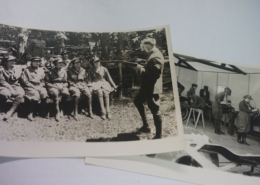Have a Cocktail with the 1919 Pierce Arrow Roadster
Strolling the grounds of Tudor Place, across the back driveway and to the garage, if the weather is nice, you will find the garage door open to display a 1919 Pierce Arrow Roadster. This antique car, now decommissioned, belonged to Armistead Peter, 3rd and was one of many Pierce Arrow Roadsters owned by the Peter Family. It is the highlighted object at the upcoming Tudor Nights Coctail Event on September 30 6-8 p.m. (free for members! details: www.tudorplace.org/calendar.html ) So I thought I would share a little of its history to prepare you for the excitement of seeing it up close…
 |
| Photo by Cathy Kerkham |
The Peter family had a long history with the Pierce-Arrow Motor Car Company. Armistead Peter, Jr. and his wife, ‘Nannie’, bought their first Pierce-Arrow in 1913. It was a 48-B2 Vestibule Suburban and cost $6,353.90. Between 1914 and 1920 the Peter family purchased at least four more Pierce-Arrows.
In 1920 they purchased a Town Brougham for a staggering $8,958.00! The Pierce-Arrow currently on display was purchased in 1919 for their son, Armistead Peter 3rd in 1919. It was his second Pierce-Arrow and proved to be his favorite. It is the only Pierce-Arrow he retained from its purchase until his death in 1983. The chassis was bought from the local Washington, DC Pierce dealer, The Foss Hughes Company, for $5,441.25. The body however, was built by the Brewster Company in New York, at a cost of $3,041.45.
Mr. Peter was actively involved in the design process. In the exhibit case are some copies of his designs. He asked Brewster to incorporate a new seat-to-steering wheel ratio designed by Rolls Royce to accommodate his height. The headlights are also by Rolls Royce. There is a box on each side of the running board. One contained the very light Arctic Brand oil that the car used, while the other held tools. A mobile tool kit was essential for an early twentieth century driver. In the 1920s service stations were not commonplace and therefore a driver needed not only to know how to maintain the car but also how to fix it when necessary. This Roadster covered some 37,000 miles, with few problems. Mr. Peter ordered the new Budd-Michelin disc wheels used on General Pershing’s car during World War 1. They were the first to be installed on a civilian car in the Washington area. An earlier skid on an icy winter road had led to a broken wooden spoke wheel, so Mr. Peter was keen to not repeat the performance.
 |
| Armistead Peter, 3rd in the 1919 Pierce-Arrow Roadster Model 48-B5 |
In 1973 Armistead Peter 3rd decided to have the car restored to its original condition. The body and works were restored to running condition and Mr. Peter finally drove it home in 1977. Afterwards he wrote, “When the car was delivered to me in Bethesda, Maryland, I drove it the seven miles to my home here in Washington, and I admit that it felt more like a truck than a car. Everything was built very heavily in those cars, including the gears, and a special trick has to be employed in shifting which I still remembered, although I had not driven the car for forty-seven years.”
Posted by: Heather Bartlow


























